Snow pea tips stir fried with aromatic garlic and ginger in a tasty light sauce. These quick and easy Stir Fried Snow Pea Leaves are ready in 10 minutes with minimal and simple ingredients. They're better-than-takeout saving you money!
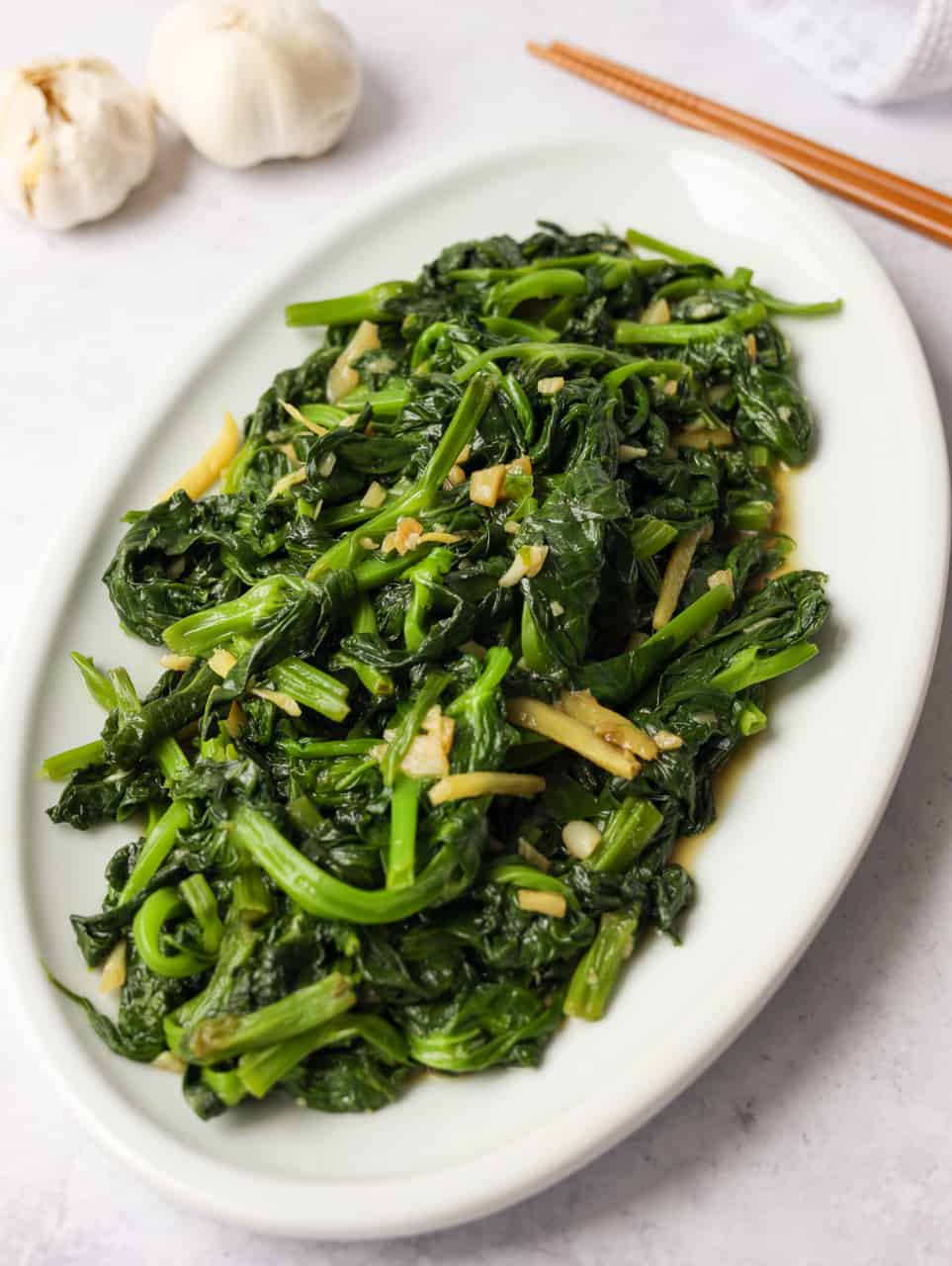
Jump to:
Stir Fried Snow Pea Leaves are a delicious and popular Chinese vegetable dish. The tender snow pea leaves are stir fried in garlic and ginger in a simple sauce made of soy sauce, oyster sauce (or vegetarian stir fry sauce if you're vegan), sesame oil, Shaoxing wine and white pepper.
Many Chinese restaurants serve this as a tasty vegetable side dish and you'll find this on many menus. It's a favourite among many because the leaves are soft and flavorful in that light garlic sauce!
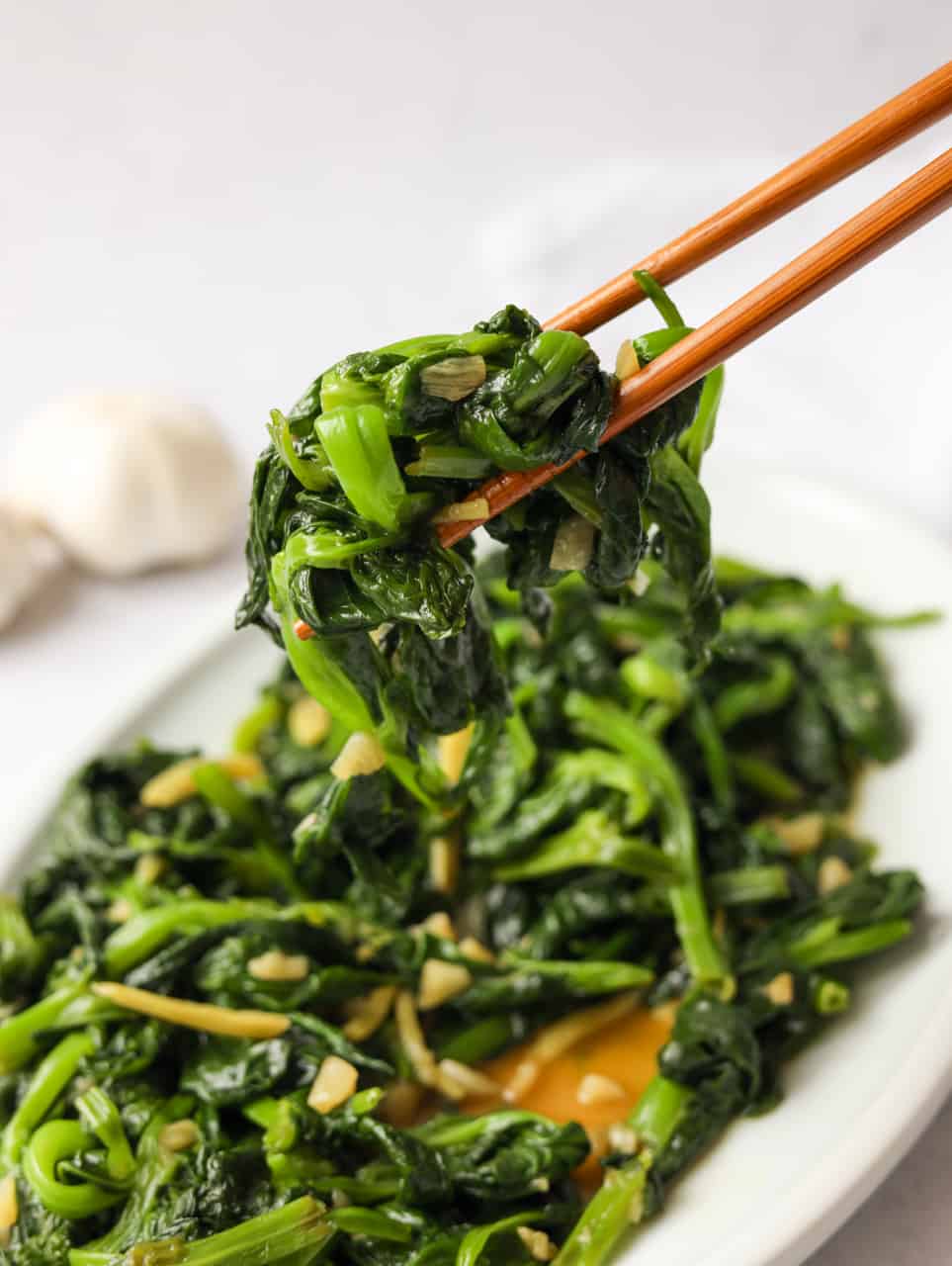

My husband and I love to order this Asian dish to add greens to our diet. We usually order it as a side with other Chinese dishes, like sweet and sour chicken with steamed rice.
When these veggies are cooked in a flaming hot wok, the 'wok hei' or smoke in the wok infuses into the greens making it extra delicious. If you have a wok, it'll be to your advantage but if you don't, a large pan works fine but you won't get that smoky flavor.
This simple dish is great for a weeknight meal for a large family if you double the portion. The whole recipe takes 10 minutes to cook from start to finish!
Ingredients & Substitutes
Please scroll down to the below Recipe card for exact measurements.
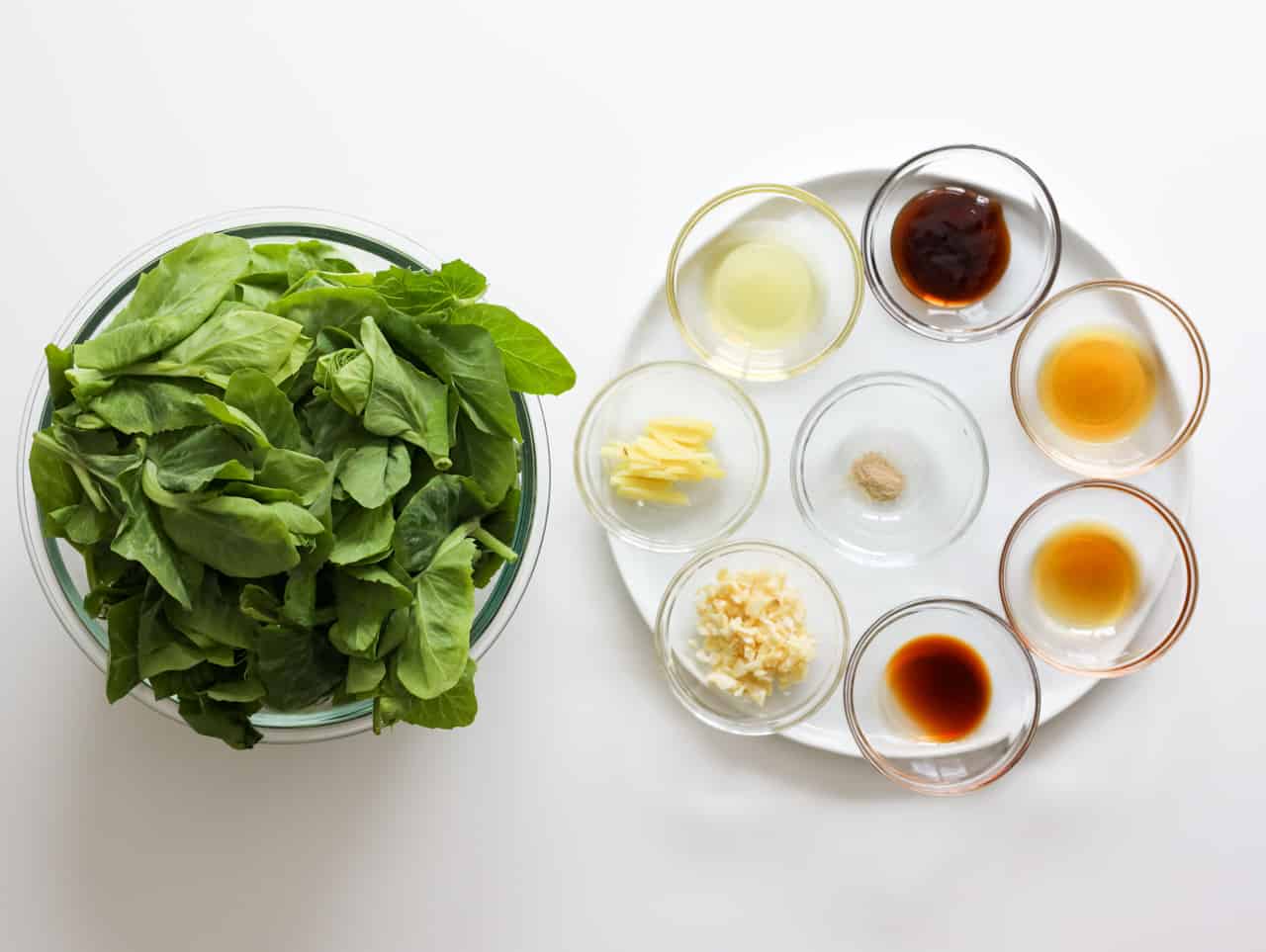

Note: Your Asian grocery store will carry most of the Asian specific ingredients.
- Snow Pea Leaves: These are not the same as pea sprouts or snow peas and they are leafy with small tendrils. Usually grown in the early summer, around June. Most Chinese grocery stores will sell them. Choose vibrant green ones without any yellowing leaves and remove any curly stems for a more pleasant texture.
- Fresh Garlic Cloves: it's best to use larger cloves for extra garlic flavor!
- Fresh Ginger: fresh peeled and sliced ginger works best for this dish. Or as a last resort, substitute with ginger powder but please only use ½ teaspoon.
- Neutral oil: like avocado oil, sunflower oil, grapeseed oil, peanut oil, vegetable oil or canola oil with a high smoke point. Avoid olive oil that has a low smoke point.
Sauce
- Oyster sauce: this is a thick brown sauce made of oysters that adds a lot of umami flavor to the dish. If you're not a fan of oysters or vegan: substitute with vegetarian stir-fry sauce. If you're gluten-free: substitute with a gluten-free version.
- Shaoxing wine: a Chinese rice cooking wine. Or substitute with Dry Sherry. For a non-alcoholic or gluten-free version, substitute with any broth.
- Regular soy sauce: or substitute with low sodium soy sauce or light soy sauce. If you’re gluten-free, substitute with tamari sauce, coconut aminos or a gluten-free soy sauce.
- Sesame oil: for that nutty flavor! If you're allergic, please omit altogether.
- White pepper: or substitute with black pepper.
Expert Tips
- Source vibrant green snow pea leaves that looks fresh because this is your main ingredient.
- Wash snow pea leaves very well. Make sure the water runs clear and you don't see or feel any dirt or insects!
- Remove any curly tendrils or tough stems by hand. These make the snow pea leaves less tender and you won't want to be chewing on them.
- Prepare the ingredients in advance because the cooking process is fast, especially the sauce!
- Don't overcook the aromatics, 10 seconds is sufficient or it can burn the garlic leaving a bitter taste.
- Don't overcook the snow pea leaves. Once they soften in the sauce, it's time to remove them from the heat.
Instructions
Below are step-by-step instructions on how to make stir fried snow pea leaves:
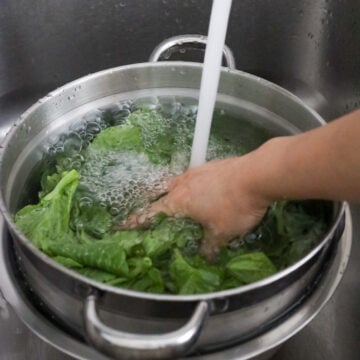

- Wash the snow pea leaves in cold water until water runs clear to remove any dirt.
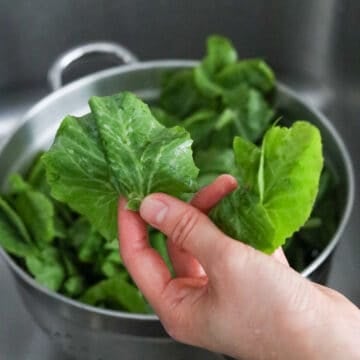

- Strain out as much excess water in the leaves as possible. If needed, remove any tough stems or curly tendrils by hand.
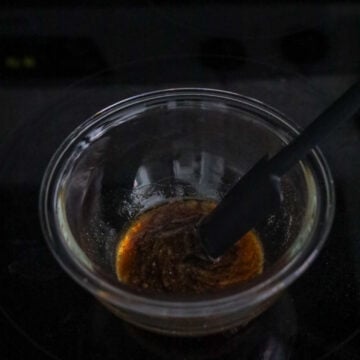

- In a small bowl, mix sauce ingredients until combined and set aside.


- Heat vegetable oil in a large wok or pan on medium heat. Stir fry ginger and garlic until fragrant, about 10 seconds.
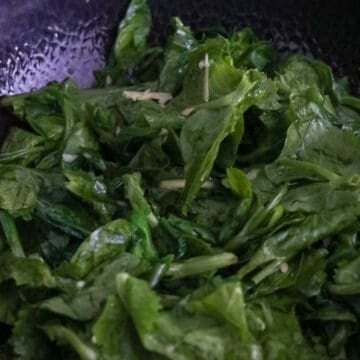

- Next toss in snow pea leaves and mix with garlic and ginger. Cook until snow pea leaves have softened, about 1-2 minutes.
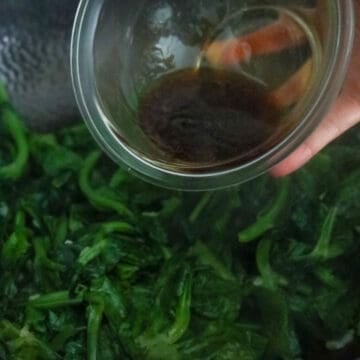

- Increase to medium-high heat, then pour in the Sauce mixture and toss with leaves.
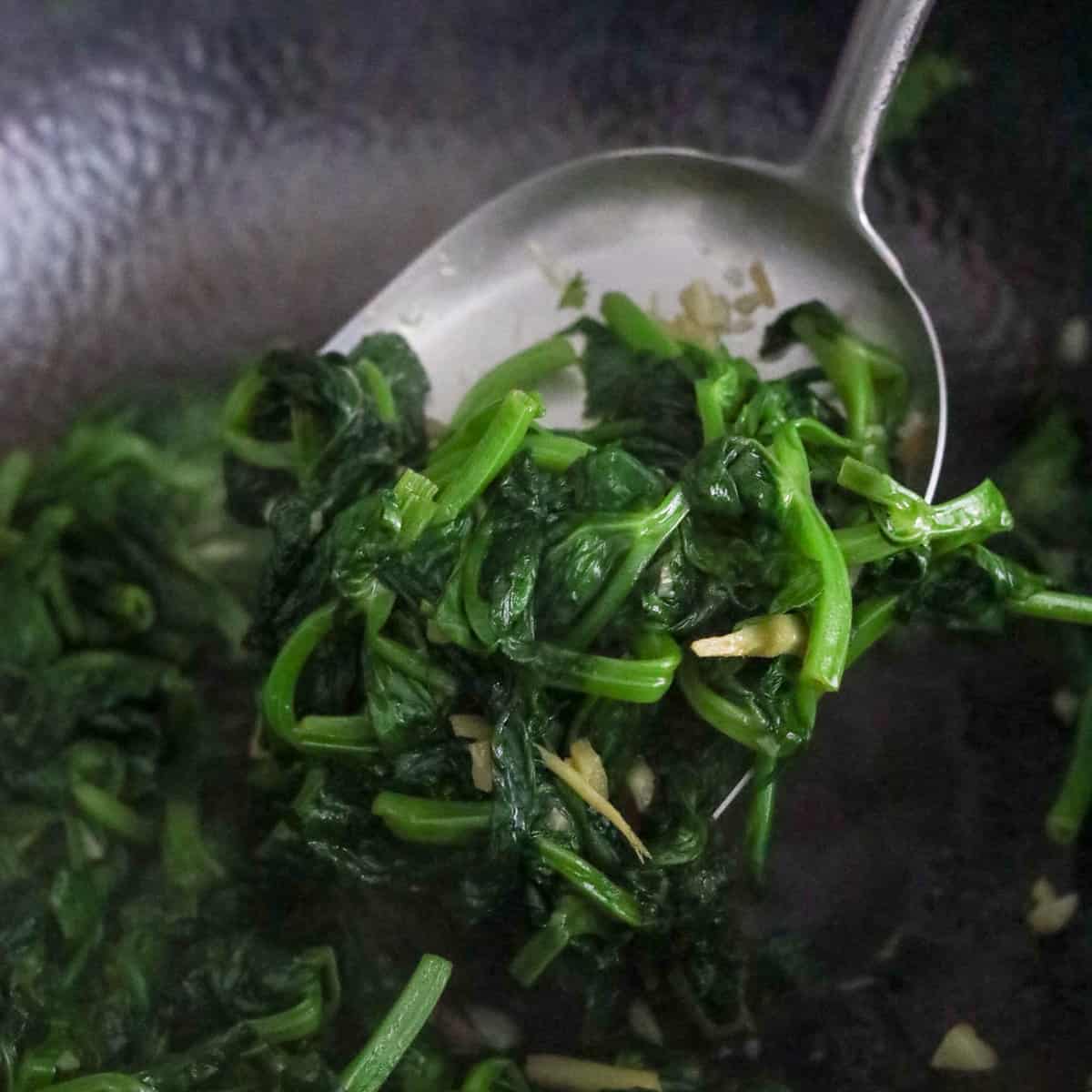

- Remove off heat and transfer to a large serving plate. Do not overcook. Enjoy!
Storage
- Leftovers will last up to 4 days stored in an airtight container in the refrigerator. To reheat: microwave for 2-3 minutes until hot or reheat in a pan on medium heat.
- Freezer friendly? I don't recommend freezing stir fried snow pea leaves as they will become mushy.
Pairing Suggestions
Stir fried snow pea leaves serve well with:
- starters like egg rolls, crab rangoons, egg drop soup, hot and sour soup
- white or brown rice, cauliflower rice, fried rice, chow mein, lo mein, plain noodles, soup noodles
- other cooked vegetables like bok choy, spicy garlic bok choy, choy sum, gai lan, or garlic green beans.
- protein dishes like Lemon Chicken, Cashew Chicken, Mongolian Beef, Honey Walnut Shrimp, Bang Bang Shrimp, Gochujang Chicken, Soy Garlic Tofu, Chinese Braised Tofu and more!
FAQ
Stir fried snow pea leaves can be made in advance and stored in an airtight container in the fridge for up to 4 days. To enjoy, reheat it in the microwave or in a pan on the stovetop on medium heat.
Snow pea leaves are vibrant leafy green attached to small tender stalks or thin stems and sometimes with budding flowers. Each leaf is about 3 inches tall and 2 inches wide.
The leaves are soft and are slightly more tender than the texture of kale for comparison. They have curly ends attached to the leaves, which should be removed for best taste. Depending on how old the pea shoots are, you may need to remove tough stems.
These are also the same leaves that grow attached to snow peas and they grow in early summer.
It's not necessary to chop snow pea leaves into smaller pieces because they usually come in manageable pieces. However, I would recommend removing the tendrils.
Snow pea leaves can easily be overcooked so it's important to monitor them. As soon as you see that they've become softened and have been mixed with the sauce you can remove it off the heat source.
Snow pea leaves should not be blanched prior to stir frying or they will overcook.
Other Recipes You May Like
- Steamed Garlic Bok Choy
- Chinese Broccoli Stir Fry
- Choy Sum with Sizzling Oil
📖 Recipe
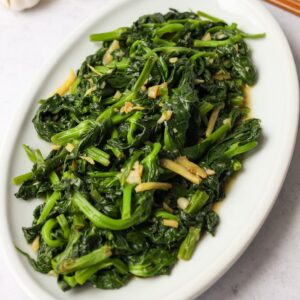

Easy 10-min. Stir Fried Snow Pea Leaves with Garlic
- 0.75 lb snow pea leaves
- 3 large cloves garlic minced
- 1 tablespoon ginger peeled and julienned
- 2 teaspoon vegetable oil or any neutral oil
Sauce
- 1 tablespoon oyster sauce or vegetarian stir fry sauce
- 2 teaspoon Shaoxing wine or Dry Sherry wine or broth of choice for a non-alcoholic version
- 1 teaspoon regular soy sauce
- 1 teaspoon sesame oil
- ⅛ teaspoon white pepper or black pepper
- Wash the snow pea leaves in cold water until water runs clear to remove any dirt.
- Strain out as much excess water in the leaves as possible. If needed, remove any tough stems or curly tendrils by hand.
- In a small bowl, mix sauce ingredients until combined and set aside.
- Heat vegetable oil in a large wok or pan on medium heat. Stir fry ginger and garlic until fragrant, about 10 seconds.
- Next toss in snow pea leaves and mix with garlic and ginger. Cook until snow pea leaves have softened, about 1-2 minutes.
- Increase to medium-high heat, then pour in the Sauce mixture and toss with leaves.
- Remove off heat and transfer to a large serving plate. Do not overcook. Enjoy!

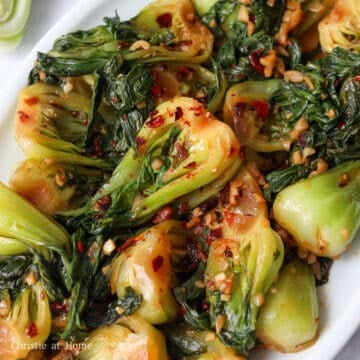
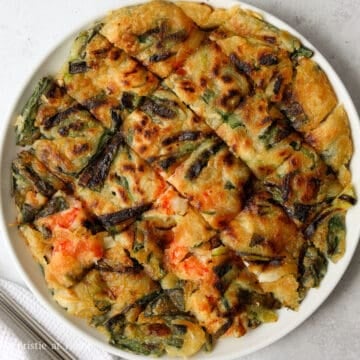
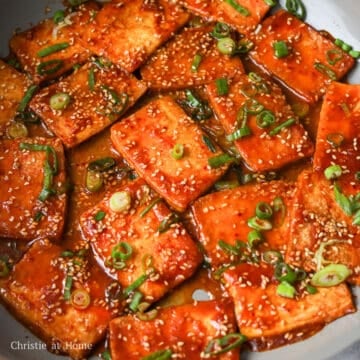
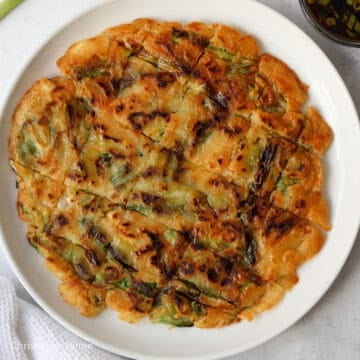
Joy
I love your recipes! Do you have any tips on making a big batch for parties?
christieathome
Thank you so much Joy! So glad you enjoy my recipes 🙂 As for tips on making a large batch for parties, if for instance you choose to quadruple the quantity, I would suggest preparing the ingredients in advance. Then when you cook them, cook the leaves in two batches. By cooking in batches, this prevents undercooking or overcooking of ingredients since the quantity is increased and there's only so much space in the pan. I would also suggest not to cook the dish too far in advance, since the salt from the sauce will naturally pull out more water from the leaves due to osmosis. I may even suggest, cooking the leaves and sauce separately and mixing the sauce in when you're ready to serve to avoid osmosis. Hope this all helps!
Jessie
Yums!!! This is my favourite veggie 😋 I've never cooked it the way you do. I've always just stuck with garlic and oil and salt. I'll definitely try your sauce next time to mix up the flavouring. Looking forward to trying your recipe .
Christie
Thanks Jessie! Garlic, oil and salt make any vegetable taste good so you can't go wrong with that 🙂 Hope you enjoy my recipe.